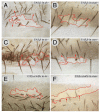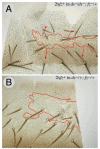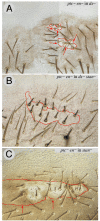Two separate molecular systems, Dachsous/Fat and Starry night/Frizzled, act independently to confer planar cell polarity
- PMID: 17075008
- PMCID: PMC2747022
- DOI: 10.1242/dev.02641
Two separate molecular systems, Dachsous/Fat and Starry night/Frizzled, act independently to confer planar cell polarity
Abstract
Planar polarity is a fundamental property of epithelia in animals and plants. In Drosophila it depends on at least two sets of genes: one set, the Ds system, encodes the cadherins Dachsous (Ds) and Fat (Ft), as well as the Golgi protein Four-jointed. The other set, the Stan system, encodes Starry night (Stan or Flamingo) and Frizzled. The prevailing view is that the Ds system acts via the Stan system to orient cells. However, using the Drosophila abdomen, we find instead that the two systems operate independently: each confers and propagates polarity, and can do so in the absence of the other. We ask how the Ds system acts; we find that either Ds or Ft is required in cells that send information and we show that both Ds and Ft are required in the responding cells. We consider how polarity may be propagated by Ds-Ft heterodimers acting as bridges between cells.
Figures







Similar articles
-
Planar cell polarity: the prickle gene acts independently on both the Ds/Ft and the Stan/Fz systems.Development. 2018 Sep 17;145(18):dev168112. doi: 10.1242/dev.168112. Development. 2018. PMID: 30154173 Free PMC article.
-
Two frizzled planar cell polarity signals in the Drosophila wing are differentially organized by the Fat/Dachsous pathway.PLoS Genet. 2011 Feb;7(2):e1001305. doi: 10.1371/journal.pgen.1001305. Epub 2011 Feb 17. PLoS Genet. 2011. PMID: 21379328 Free PMC article.
-
Dissecting the molecular bridges that mediate the function of Frizzled in planar cell polarity.Development. 2012 Oct;139(19):3665-74. doi: 10.1242/dev.083550. Development. 2012. PMID: 22949620 Free PMC article.
-
The roles of the cadherins Fat and Dachsous in planar polarity specification in Drosophila.Dev Dyn. 2012 Jan;241(1):27-39. doi: 10.1002/dvdy.22736. Epub 2011 Sep 14. Dev Dyn. 2012. PMID: 21919123 Review.
-
The frizzled/stan pathway and planar cell polarity in the Drosophila wing.Curr Top Dev Biol. 2012;101:1-31. doi: 10.1016/B978-0-12-394592-1.00001-6. Curr Top Dev Biol. 2012. PMID: 23140623 Free PMC article. Review.
Cited by
-
Planar polarity specification through asymmetric subcellular localization of Fat and Dachsous.Curr Biol. 2012 May 22;22(10):907-14. doi: 10.1016/j.cub.2012.03.053. Epub 2012 Apr 12. Curr Biol. 2012. PMID: 22503504 Free PMC article.
-
Separating planar cell polarity and Hippo pathway activities of the protocadherins Fat and Dachsous.Development. 2012 Apr;139(8):1498-508. doi: 10.1242/dev.070367. Epub 2012 Mar 7. Development. 2012. PMID: 22399682 Free PMC article.
-
PCP and Wnt pathway components act in parallel during zebrafish mechanosensory hair cell orientation.Nat Commun. 2019 Sep 5;10(1):3993. doi: 10.1038/s41467-019-12005-y. Nat Commun. 2019. PMID: 31488837 Free PMC article.
-
Serrano (sano) functions with the planar cell polarity genes to control tracheal tube length.PLoS Genet. 2009 Nov;5(11):e1000746. doi: 10.1371/journal.pgen.1000746. Epub 2009 Nov 26. PLoS Genet. 2009. PMID: 19956736 Free PMC article.
-
Planar cell polarity in kidney development and disease.Organogenesis. 2011 Jul-Sep;7(3):180-90. doi: 10.4161/org.7.3.18320. Epub 2011 Jul 1. Organogenesis. 2011. PMID: 22027435 Free PMC article. Review.
References
-
- Adler PN. Planar signaling and morphogenesis in Drosophila. Dev Cell. 2002;2:525–35. - PubMed
-
- Adler PN, Charlton J, Liu J. Mutations in the cadherin superfamily member gene dachsous cause a tissue polarity phenotype by altering frizzled signaling. Development. 1998;125:959–68. - PubMed
-
- Adler PN, Krasnow RE, Liu J. Tissue polarity points from cells that have higher Frizzled levels towards cells that have lower Frizzled levels. Curr Biol. 1997;7:940–9. - PubMed
-
- Amonlirdviman K, Khare NA, Tree DR, Chen WS, Axelrod JD, Tomlin CJ. Mathematical modeling of planar cell polarity to understand domineering nonautonomy. Science. 2005;307:423–6. - PubMed
-
- Baena-López LA, Baonza A, Garcia-Bellido A. The orientation of cell divisions determines the shape of Drosophila organs. Curr Biol. 2005;15:1640–4. - PubMed
Publication types
MeSH terms
Substances
Grants and funding
LinkOut - more resources
Full Text Sources
Other Literature Sources
Molecular Biology Databases

